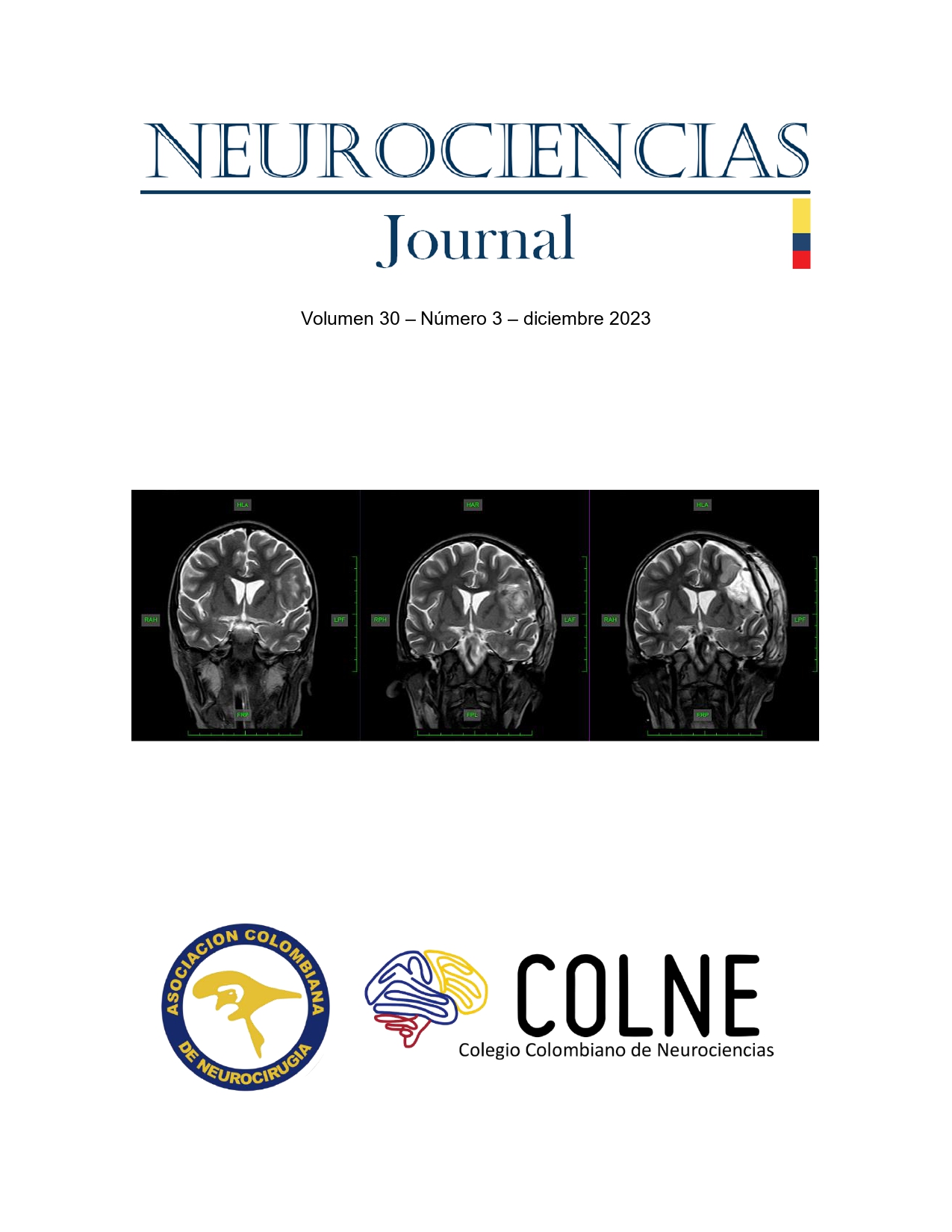Ki-67 Proliferation Index Correlates to IDH-1 Mutation Status in High-Grade Gliomas
DOI:
https://doi.org/10.51437/nj.v30i3.458Palabras clave:
High-grade Glioma, Glioblastoma, Ki-67, IDH-1, CorrelationResumen
Objectives: Molecular diagnosis is essential to establish the behavior of the tumor and the prognosis of patients with HGG. The IDH1 mutation status represents the cornerstone for the current diagnosis of these tumors and is associated with prognosis. We hypothesized that Ki-67 proliferation index may be related to IDH mutation status and this relationship may be used to better categorize HGG in emerging economies.
Methods: An institutional database was reviewed for high-grade gliomas treated in the period from January 2020 to December 2021. Patients with a HGG that the pathology report had information regarding IDH-1 mutation status, Ki-67 proliferation index and p53 overexpression were included. The statistical analysis was performed using the software SPSS® (IBM) version 25.
Results: A total of 25 patients were included in the study. We found mutation for IDH1 in 8 patients, while 17 patients retained the wild-type variant. Nine patients had a Ki-67 of 20% or less while the remaining 16 had a proliferation index above 20%. Statistical analysis showed a positive correlation between Ki-67 index and IDH1 status.
Conclusion: Our findings suggest that there is a positive relationship between a high Ki-67 proliferation index and the lack of IDH1 mutation in HGG.
Citas
Ostrom QT, Gittleman H, Fulop J, Liu M, Blanda R, Kromer C, et al. CBTRUS statistical report: primary brain and central nervous system tumours diagnosed in the United States in 2008-2012. Neuro Oncol 2015;17: iv1-62.
Louis DN, Ohgaki H, Wiestler OD, Cavenee WK, editors. WHO Classification of Tumours of the Central Nervous System. 4th ed. 10-122. Lyon, France: International Agency for Research on Cancer; 2016.
Jonat W, Arnold N. Is the Ki-67 labelling index ready for clinical use? Ann Oncol 2011;22:500–2.
Wong E, Nahar N, Hau E, Varikatt W, Gebski V, Ng T, Jayamohan J, Sundaresan P. Cut-point for Ki-67 proliferation index as a prognostic marker for glioblastoma. Asia Pac J Clin Oncol. 2019 Feb;15(1):5-9.
Alkhaibary A, Alassiri AH, AlSufiani F, Alharbi MA. Ki-67 labeling index in glioblastoma; does it really matter? Hematol Oncol Stem Cell Ther. 2019 Jun;12(2):82-88.
Armocida D, Frati A, Salvati M, Santoro A, Pesce A. Is Ki-67 index overexpression in IDH wild type glioblastoma a predictor of shorter Progression Free survival? A clinical and Molecular analytic investigation. Clin Neurol Neurosurg. 2020 Nov;198:106126.
Dahlrot RH, Bangsø JA, Petersen JK, Rosager AM, Sørensen MD, Reifenberger G, Hansen S, Kristensen BW. Prognostic role of Ki-67 in glioblastomas excluding contribution from non-neoplastic cells. Sci Rep. 2021 Sep 9;11(1):17918.
van den Bent MJ. Interobserver variation of the histopathological diagnosis in clinical trials on glioma: a clinician's perspective. Acta Neuropathol. 2010 Sep;120(3):297-304.
Suzuki H, Aoki K, Chiba K, Sato Y, Shiozawa Y, et al. Mutational landscape and clonal architecture in grade II and III gliomas. Nat Genet. 2015 May;47(5):458-68.
Wiestler B, Capper D, Sill M, Jones DT, et al. Integrated DNA methylation and copy-number profiling identify three clinically and biologically relevant groups of anaplastic glioma. Acta Neuropathol. 2014 Oct;128(4):561-71.
Weller M, Weber RG, Willscher E, et al. Molecular classification of diffuse cerebral WHO grade II/III gliomas using genome- and transcriptome-wide profiling improves stratification of prognostically distinct patient groups. Acta Neuropathol. 2015 May;129(5):679-93.
Louis DN, Ohgaki H, Wiestler OD, Cavenee WK, editors. WHO Classification of Tumours of the Central Nervous System. 4th ed. 10-122. Lyon, France: International Agency for Research on Cancer; 2016.
Reifenberger G, Wirsching HG, Knobbe-Thomsen CB, Weller M. Advances in the molecular genetics of gliomas - implications for classification and therapy. Nat Rev Clin Oncol. 2017 Jul;14(7):434-452.
Xu W, Yang H, Liu Y, et al. Oncometabolite 2-hydroxyglutarate is a competitive inhibitor of α-ketoglutarate-dependent dioxygenases. Cancer Cell. 2011 Jan 18;19(1):17-30.
Malta TM, de Souza CF, Sabedot TS, Silva TC, et al. Glioma CpG island methylator phenotype (G-CIMP): biological and clinical implications. Neuro Oncol. 2018 Apr 9;20(5):608-620.
Watanabe T, Nobusawa S, Kleihues P, Ohgaki H. IDH1 mutations are early events in the development of astrocytomas and oligodendrogliomas. Am J Pathol. 2009 Apr;174(4):1149-53.
Paľa A, Coburger J, Scherer M, Ahmeti H, et al. To treat or not to treat? A retrospective multicenter assessment of survival in patients with IDH-mutant low-grade glioma based on adjuvant treatment. J Neurosurg. 2019 Jul 19:1-8.
Berzero G, Di Stefano AL, Ronchi S, Bielle F, el al. IDH-wildtype lower-grade diffuse gliomas: the importance of histological grade and molecular assessment for prognostic stratification. Neuro Oncol. 2021 Jun 1;23(6):955-966.
Salem A, Hashem SA, Al-Rashdan A, Ezam N, Nour A, Alsharbaji A, Sughayer M, Mohamad I, Elyan M, Addas A, Al-Hussaini M, Almousa A. The challenges of managing glioblastoma multiforme in developing countries: a trade-off between cost and quality of care. Hematol Oncol Stem Cell Ther. 2011;4(3):116-20.
Vanacôr C, Duffau H. Analysis of Legal, Cultural, and Socioeconomic Parameters in Low-Grade Glioma Management: Variability Across Countries and Implications for Awake Surgery. World Neurosurg. 2018 Dec;120:47-53.
Johannessen AL, Torp SH. The clinical value of Ki-67/MIB-1 labeling index in human astrocytomas. Pathol Oncol Res. 2006;12(3):143-7.
Cai J, Zhang C, Zhang W, Wang G, Yao K, Wang Z, Li G, Qian Z, Li Y, Jiang T, Jiang C. ATRX, IDH1-R132H and Ki-67 immunohistochemistry as a classification scheme for astrocytic tumors. Oncoscience. 2016 Sep 6;3(7-8):258-265.
Louis DN, Perry A, Wesseling P, Brat DJ, Cree IA, Figarella-Branger D, Hawkins C, Ng HK, Pfister SM, Reifenberger G, Soffietti R, von Deimling A, Ellison DW. The 2021 WHO Classification of Tumors of the Central Nervous System: a summary. Neuro Oncol. 2021 Aug 2;23(8):1231-1251.
Descargas
Publicado
Cómo citar
Número
Sección
Licencia
Derechos de autor 2024 Neurociencias Journal

Esta obra está bajo una licencia internacional Creative Commons Atribución-NoComercial-SinDerivadas 4.0.


